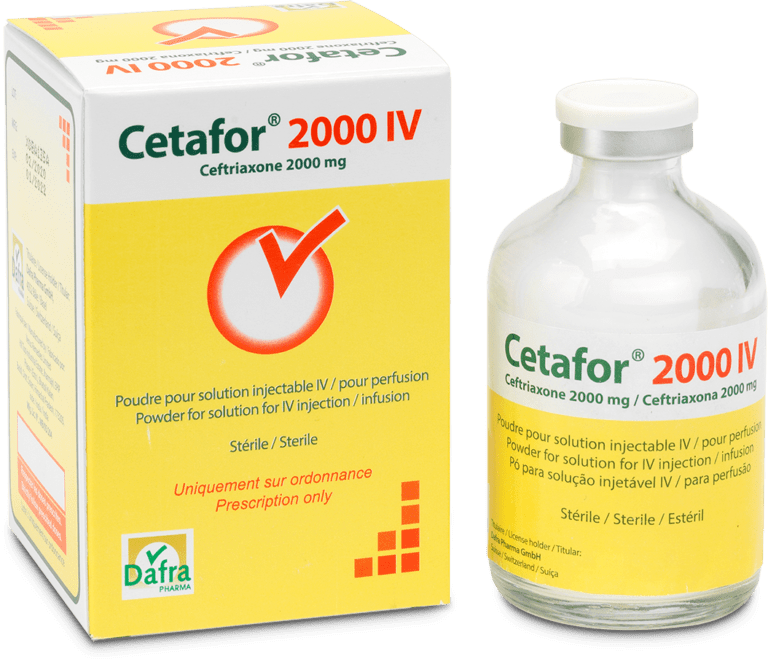
Active substance: ceftriaxone (injectable 3rd generation cephalosporin)
Form: 2000 mg powder for solution for injection (IV injection -perfusion)
Other available forms of Cetafor
Cetafor® 500 IV: ceftriaxone 500 mg + solvent (water for injection 5 ml)
Cetafor® 1000 IV: ceftriaxone 1000 mg + solvent (water for injection 10 ml)
Cetafor® 1000 IM: ceftriaxone 1000 mg + solvent (lidocaïne 1% 4 ml)
Packaging: Box with one powder vial
Target: adults and children (including in term neonates)
Cetafor is indicated for the treatment of the following infections in adults and children
including term neonates (from birth):
Cetafor may be used:
Cetafor should be co-administered with other antibacterial agents whenever the possible range of causative bacteria would not fall within its spectrum.
The dose of Cetafor depends on the severity, susceptibility, site and type of infection and on the age and hepato-renal function of the patient.
The duration of therapy varies according to the course of the disease. As with antibiotic therapy in general, administration of ceftriaxone should be continued for 48 – 72 hours after the patient has become afebrile or evidence of bacterial eradication has been achieved.
IV form
IV bolus injection :
Cetafor® IV (500 mg, 1000 mg and 2000 mg) should be administered by intravenous injection. For Cetafor 500 mg and Cetafor 1000 mg the solution is prepared with the 5 ml/10 ml/20 ml ampoule supplied in the same box.
For Cetafor 2000 mg: dissolve the product in 20 ml of water for injection
The solution should be administered directly after reconstitution by the IV route over a period of 2.5 minutes per 5 ml.
IV infusion
For IV infusion, Cetafor 2000 IV is dissolved in 40 ml of one of the following calciumfree infusion fluids: sodium chloride 0.9%, sodium chloride 0.45% + dextrose 2.5%, dextrose 5%, dextrose 10%, dextran 6% in dextrose 5%, hydroxyethyl-starch 6-10%, water for injections. The infusion should be administered over at least 30 minutes.
When adding 40ml of water for injections, the final concentration of the reconstituted solution is 48.34 mg/ml. In neonates, intravenous doses should be given over 60 minutes to reduce potential risk of bilirubin encephalopathy.
All these solutions should be administered immediately after reconstitution.
Solutions containing ceftriaxone should not be mixed or added to other agents. In particular, ceftriaxone is not compatible with calcium-containing solutions such as Hartmann’s solution and Ringer’s solution. Ceftriaxone should not be mixed or administered simultaneously with solutions containing calcium.
Prescription drugs. Please contact your doctor.

| Cookie | Duration | Description |
|---|---|---|
| cookielawinfo-checbox-analytics | 11 months | This cookie is set by GDPR Cookie Consent plugin. The cookie is used to store the user consent for the cookies in the category "Analytics". |
| cookielawinfo-checbox-functional | 11 months | The cookie is set by GDPR cookie consent to record the user consent for the cookies in the category "Functional". |
| cookielawinfo-checbox-others | 11 months | This cookie is set by GDPR Cookie Consent plugin. The cookie is used to store the user consent for the cookies in the category "Other. |
| cookielawinfo-checkbox-necessary | 11 months | This cookie is set by GDPR Cookie Consent plugin. The cookies is used to store the user consent for the cookies in the category "Necessary". |
| cookielawinfo-checkbox-performance | 11 months | This cookie is set by GDPR Cookie Consent plugin. The cookie is used to store the user consent for the cookies in the category "Performance". |
| viewed_cookie_policy | 11 months | The cookie is set by the GDPR Cookie Consent plugin and is used to store whether or not user has consented to the use of cookies. It does not store any personal data. |